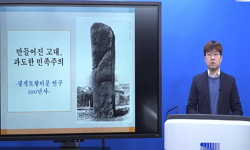This article examines various views about the racial origin of Koguryo presented by Chinese historians, especially discusses in detail the substances and problems of 'Theory of Sang People's Descendant' among these views. The Chinese Historians that p...
http://chineseinput.net/에서 pinyin(병음)방식으로 중국어를 변환할 수 있습니다.
변환된 중국어를 복사하여 사용하시면 됩니다.
- 中文 을 입력하시려면 zhongwen을 입력하시고 space를누르시면됩니다.
- 北京 을 입력하시려면 beijing을 입력하시고 space를 누르시면 됩니다.
https://www.riss.kr/link?id=A76356369
- 저자
- 발행기관
- 학술지명
- 권호사항
-
발행연도
2007
-
작성언어
Korean
- 주제어
-
등재정보
KCI등재후보
-
자료형태
학술저널
-
수록면
9-25(17쪽)
-
KCI 피인용횟수
3
- 제공처
-
0
상세조회 -
0
다운로드
부가정보
다국어 초록 (Multilingual Abstract)
Nevertheless, the Chinese Historians present the Theory of Sang People's Descendant that is vulnerable logically, in order to separate Goguryeo from Korean History, to be connected with Chinese History in the origin of race, and to include Koguryo among Chinese History in the end. The Theory of Sang People's Descendant is a minority opinion, and not a main current in Chinese academic circles yet. But we must not exclude possibility that it will become a public theory of the Chinese academic world, considering the YongDam Mountain Fottress' s guidebook written that "there is no doubt that Koguryo is evolved from the Sang Dynasty, judging from the results of the latest research based on the documents and archeological evidence", the fact that Kyong Cheol Hwa is a leader of the DongBuk-GongJeong (Research Project on the Chinese East-North Area), In that respect, Korean historians had to pay attention to historical research trends in China.
This article examines various views about the racial origin of Koguryo presented by Chinese historians, especially discusses in detail the substances and problems of 'Theory of Sang People's Descendant' among these views. The Chinese Historians that presented Theory of Sang People's Descendant emphasize their point based on the various grounds, but can't verify correlation between Koguryo and Sang People documentarily. Moreover, various grounds presented by them can't explain more than effects of the cultural exchange.
Nevertheless, the Chinese Historians present the Theory of Sang People's Descendant that is vulnerable logically, in order to separate Goguryeo from Korean History, to be connected with Chinese History in the origin of race, and to include Koguryo among Chinese History in the end. The Theory of Sang People's Descendant is a minority opinion, and not a main current in Chinese academic circles yet. But we must not exclude possibility that it will become a public theory of the Chinese academic world, considering the YongDam Mountain Fottress' s guidebook written that "there is no doubt that Koguryo is evolved from the Sang Dynasty, judging from the results of the latest research based on the documents and archeological evidence", the fact that Kyong Cheol Hwa is a leader of the DongBuk-GongJeong (Research Project on the Chinese East-North Area), In that respect, Korean historians had to pay attention to historical research trends in China.
목차 (Table of Contents)
- Ⅰ. 서론
- Ⅱ. 중국학계의 고구려 기원에 대한 논의
- Ⅲ. 상인, 염황후예설의 제기
- Ⅳ. 상인, 염황후예론의 내용과 비판
- Ⅴ. 결론
- Ⅰ. 서론
- Ⅱ. 중국학계의 고구려 기원에 대한 논의
- Ⅲ. 상인, 염황후예설의 제기
- Ⅳ. 상인, 염황후예론의 내용과 비판
- Ⅴ. 결론
- 〈Abstract〉
동일학술지(권/호) 다른 논문
-
- 고구려발해학회
- 서길수(徐吉洙)
- 2007
- KCI등재후보
-
- 고구려발해학회
- 송호정(SONG Ho-jung)
- 2007
- KCI등재후보
-
- 고구려발해학회
- 이도학(LEE Do-hack)
- 2007
- KCI등재후보
-
- 고구려발해학회
- 지병목(JI Byong-mok)
- 2007
- KCI등재후보
분석정보
인용정보 인용지수 설명보기
학술지 이력
| 연월일 | 이력구분 | 이력상세 | 등재구분 |
|---|---|---|---|
| 2028 | 평가예정 | 재인증평가 신청대상 (재인증) | |
| 2022-01-01 | 평가 | 등재학술지 유지 (재인증) |  |
| 2021-07-02 | 학회명변경 | 영문명 : Institute of KoguryoBalhae -> Association of Koguryo Balhae |  |
| 2019-01-01 | 평가 | 등재학술지 유지 (계속평가) |  |
| 2016-01-01 | 평가 | 등재학술지 유지 (계속평가) |  |
| 2012-01-01 | 평가 | 등재학술지 유지 (등재유지) |  |
| 2009-01-01 | 평가 | 등재학술지 선정 (등재후보2차) |  |
| 2008-02-14 | 학술지명변경 | 한글명 : 고구려연구 -> 고구려발해연구외국어명 : The Koguryo Yonku -> The KoguryoBalhae Yonku |  |
| 2008-02-13 | 학회명변경 | 한글명 : 고구려연구회 -> 고구려발해학회영문명 : Institute of Koguryo Studies -> Institute of KoguryoBalhae |  |
| 2008-01-01 | 평가 | 등재후보 1차 PASS (등재후보1차) |  |
| 2007-01-01 | 평가 | 등재후보학술지 유지 (등재후보1차) |  |
| 2006-01-01 | 평가 | 등재후보 1차 FAIL (등재후보1차) |  |
| 2005-05-30 | 학회명변경 | 영문명 : 미등록 -> Institute of Koguryo Studies |  |
| 2005-01-01 | 평가 | 등재후보학술지 유지 (등재후보1차) |  |
| 2004-01-01 | 평가 | 등재후보학술지 유지 (등재후보1차) |  |
| 2003-01-01 | 평가 | 등재후보학술지 선정 (신규평가) |  |
학술지 인용정보
| 기준연도 | WOS-KCI 통합IF(2년) | KCIF(2년) | KCIF(3년) |
|---|---|---|---|
| 2016 | 0.78 | 0.78 | 0.93 |
| KCIF(4년) | KCIF(5년) | 중심성지수(3년) | 즉시성지수 |
| 0.9 | 0.93 | 2.013 | 0.38 |





 DBpia
DBpia





